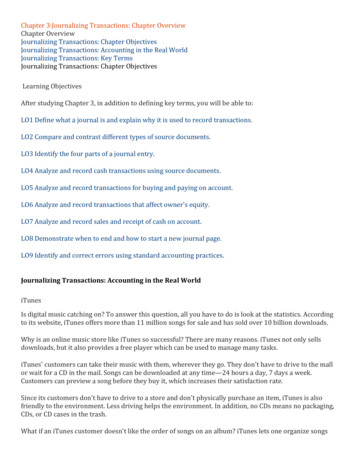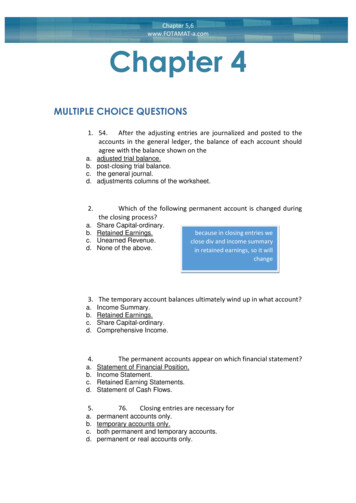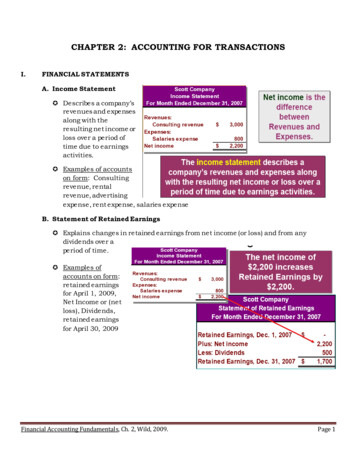
Transcription
Chapter 3:Journalizing Transactions: Chapter OverviewChapter OverviewJournalizing Transactions: Chapter ObjectivesJournalizing Transactions: Accounting in the Real WorldJournalizing Transactions: Key TermsJournalizing Transactions: Chapter ObjectivesLearning ObjectivesAfter studying Chapter 3, in addition to defining key terms, you will be able to:LO1 Define what a journal is and explain why it is used to record transactions.LO2 Compare and contrast different types of source documents.LO3 Identify the four parts of a journal entry.LO4 Analyze and record cash transactions using source documents.LO5 Analyze and record transactions for buying and paying on account.LO6 Analyze and record transactions that affect owner's equity.LO7 Analyze and record sales and receipt of cash on account.LO8 Demonstrate when to end and how to start a new journal page.LO9 Identify and correct errors using standard accounting practices.Journalizing Transactions: Accounting in the Real WorldiTunesIs digital music catching on? To answer this question, all you have to do is look at the statistics. Accordingto its website, iTunes offers more than 11 million songs for sale and has sold over 10 billion downloads.Why is an online music store like iTunes so successful? There are many reasons. iTunes not only sellsdownloads, but it also provides a free player which can be used to manage many tasks.iTunes' customers can take their music with them, wherever they go. They don't have to drive to the mallor wait for a CD in the mail. Songs can be downloaded at any time—24 hours a day, 7 days a week.Customers can preview a song before they buy it, which increases their satisfaction rate.Since its customers don't have to drive to a store and don't physically purchase an item, iTunes is alsofriendly to the environment. Less driving helps the environment. In addition, no CDs means no packaging,CDs, or CD cases in the trash.What if an iTunes customer doesn't like the order of songs on an album? iTunes lets one organize songs
in any order. iTunes also allows listeners to enjoy tunes on many portable devices. Clients can downloadmovies and college lectures as well as music.Critical Thinking1.When iTunes sells a song or movie, it must recordthe transaction in accounts. Which accounts might iTunesuse when it sells a song for cash?2. What accounts might iTunes use when it has shipping costs onaccount?Journalizing Transactions: Key Terms journaljournalizingentrydouble-entry accountingsource documentcheckinvoicesales invoicereceiptmemorandumLesson 3-1: Recording Transactions and the General JournalJournals and Journalizing LO1A General JournalSource Documents LO2Other Source DocumentsPreparing Journal EntriesReceived Cash from Owner as an Investment LO3Paid Cash for SuppliesEnd of Lesson ReviewLO1 Define what a journal is and explain why it is used to record transactions.LO2 Compare and contrast different types of source documents.LO3 Identify the four parts of a journal entry.Journals and Journalizing LO1In Chapter 2, transactions were analyzed into debit and credit parts using the accounting equation and Taccounts. Transactions could be recorded this way in a business. However, as the number of accounts
increases, the accounting equation would become very wide and difficult to use. A form for recordingtransactions in chronological order is called a journal . Most companies choose to use a journal to recordtransactions. Besides being more manageable, a journal also provides a more permanent record of thetransactions of a business. Recording transactions in a journal is called journalizing .There are several kinds of journals. Each business uses the kind of journal that best fits the needs of thatbusiness. The nature of a business and the number of transactions to be recorded determine the kind ofjournal to be used.The word journal comes from the Latin diurnalis, meaning daily. Most businesses conduct transactionsevery day. To keep records up to date, businesses usually record transactions in their journals every day.A General JournalUsing a JournalDelgado WebServices uses ageneral journal.The generaljournal has twoamountcolumns inwhich all kinds of entries can be recorded. The columns in Delgado Web Services' general journal areDate, Account Title, Doc. No., Post. Ref., Debit, and Credit. The use of each column is described later in thischapter.AccuracyInformation recorded in a journal includes the debit and credit parts of each transaction recorded in oneplace. The information can be verified by comparing the data in the journal with the transaction data.Chronological RecordTransactions are recorded in a journal in order by date. All information about a transaction is recorded inone place. This makes the information for a specific transaction easy to locate.Double-Entry AccountingInformation for each transaction recorded in a journal is called an entry . The recording of debit andcredit parts of a transaction is called double-entry accounting . In double-entry accounting, eachtransaction affects at least two accounts. Both the debit and the credit parts are recorded, reflecting thedual effect of each transaction. Double-entry accounting assures that debits equal credits.Source Documents LO2A business paper from which information is obtained for a journal entry is called a source document .Different types of source documents are used for different kinds of transactions. Each transaction isdescribed by a source document that proves that the transaction did occur. For example, Delgado WebServices prepares a check stub for each cash payment made. The check stub describes information about
the cash payment for which the check is prepared. The accounting concept Objective Evidence is appliedwhen a source document is prepared for each transaction. [CONCEPT: Objective Evidence]A transaction should be journalized only if it actually occurs. The amounts recorded must be accurate andtrue. Nearly all transactions result in the preparation of a source document. Delgado Web Services usesfive source documents: checks, sales invoices, receipts, memorandums, and calculator tapes.A business form ordering a bank to pay cash from a bank account is called a check . The sourcedocument for cash payments is a check. Delgado Web Services makes all cash payments by check. Thechecks are prenumbered to help account for all checks. Delgado Web Services' record of information on acheck is the check stub prepared at the same time as the check.Procedures for preparing checks and check stubs are described in Chapter 5.Sales InvoicesWhen services are sold on account, the seller prepares a form showing information about the sale. A formdescribing the goods or services sold, the quantity, the price, and the terms of sale is called an invoice .Terms of sale could include the due date of the invoice and any penalties for late payment. An invoiceused as a source document for recording a sale on account is called a sales invoice . A sales invoice is alsoreferred to as a sales ticket or a sales slip.A sales invoice is prepared in duplicate. The original is given to the customer. The copy is used as thesource document for the sale on account transaction. [CONCEPT: Objective Evidence]Sales invoices are prenumbered in sequence to help account for all sales invoices.Source documents can be critically important in tracking down errors. Businesses file
their source documents so they can be referred to if it is necessary to verify information entered intotheir journals.Other Source DocumentsReceiptsA business form giving written acknowledgement for cash received is called a receipt . When cash isreceived from sources other than sales, Delgado Web Services prepares a receipt. The receipts areprenumbered to help account for all of the receipts. A receipt is the source document for cash receivedfrom transactions other than sales. [CONCEPT: Objective Evidence]MemorandumsA form on which a brief message is written todescribe a transaction is called a memorandum . Amemorandum is used when there is no othersource document for a transaction. Amemorandum is also used when an additionalexplanation is needed about a transaction.[CONCEPT: Objective Evidence] Delgado WebServices' memorandums are prenumbered to helpaccount for all memorandums. A brief note iswritten on the memorandum to describe thetransaction.Calculator TapesDelgado Web Services collects cash at the time services are rendered to customers. At the end of eachday, Delgado Web Services uses a printing electronic calculator to total the amount of cash received fromsales for that day. By totaling all the individual sales, a single source document is produced for the totalsales of the day. Thus, time and space are saved by recording only one entry for all of a day's sales. The
calculator tape is the source document for daily sales. [CONCEPT: Objective Evidence] A calculator tapeused as a source document is shown here.Delgado Web Services dates and numbers each calculator tape. For example, in the illustration, thenumber T10 indicates that the tape is for the tenth day of themonth.Preparing Journal EntriesA company's journal is sometimes referred to as a “book oforiginal entry.” This means that the journal entry is the firstplace a business transaction becomes a permanent part of acompany's accounting system.Because the journal is a permanent record, accountants usuallyrecord journal entries in ink rather than pencil. When an entryin an amount column is an even dollar amount, “00” should beadded to the cents column. If the column were left blank instead,there might be a question about whether an amount was omitted.Received Cash from Owner as an Investment LO3A journal entry consists of four parts: (1) date, (2) debit, (3) credit, and (4) source document. Before atransaction is recorded in a journal, the transaction is analyzed into its debit and credit parts.January 2. Received cash from owner as an investment, 2,000.00. Receipt No. 1.The source document for this transaction isReceipt No. 1. [CONCEPT: ObjectiveEvidence] The analysis of this transactionis shown in the T accounts.The asset account, Cash, increases by adebit, 2,000.00. The owner's capitalaccount, Michael Delgado, Capital,
increases by a credit, 2,000.00.Debits must equal credits for each entry in a journal. After the entry is journalized, the equality of debitsand credits is verified. For this entry, the total debits, 2,000.00, equal the total credits, 2,000.00. Theuse of the Post. Ref. column is described in Chapter 4.Journalizing Cash Received from Owner as an Investment1 Date. Write the date, 20-- Jan. 2, in the Date column. This entry is the first one on this journal page.Therefore, write both the year and the month for this entry. Do not write either the year or the monthagain on the same page.2 Debit. Write the title of the account debited, Cash, in the Account Title column. Write the debit amount, 2,000.00, in the Debit column.3 Credit. On the next line, indented about one centimeter, write the title of the account credited, MichaelDelgado, Capital, in the Account Title column. This account title is indented to indicate that this account iscredited. Write the credit amount, 2,000.00, in the Credit column.4 Source document. On the first line of the entry, write the source document number, R1, in the Doc. No.column. The source document number, R1, indicates that this is Receipt No. 1. (The source documentnumber is a cross reference from the journal to the source document. Receipt No. 1 is filed in case moredetails about this transaction are needed.)Dollars and cents signs and decimal points are not used when writing amounts onruled accounting paper. Sometimes a color tint or a heavy vertical rule is used onprinted accounting paper to separate the dollars and cents columns.Paid Cash for SuppliesJanuary 2. Paid cash for supplies, 165.00. Check No. 1.
The source document for this transaction isCheck No. 1. [CONCEPT: ObjectiveEvidence] The analysis of this transaction isshown in the T accounts.The asset account Supplies increases by adebit, 165.00. The asset account Cashdecreases by a credit, 165.00.Journalizing Cash Paid for Supplies1 Date. Write the date, 2, in the Date column. This is not the first entry on the journal page. Therefore, donot write the year and month for this entry.2 Debit. Write the title of the account debited, Supplies, in the Account Title column. Write the debitamount, 165.00, in the Debit column.3 Credit. On the next line, indented about one centimeter, write the title of the account credited, Cash, inthe Account Title column. Write the credit amount, 165.00, in the Credit column.4 Source document. On the first line of this entry, write the source document number, C1, in the Doc. No.column. The source document number, C1, indicates that this is Check No. 1.For this entry, the total debits, 165.00, equal the total credits, 165.00.If you misspell words in your written communications, people may mistrust thequality of your accounting skills. Note that in the word receipt, the “e” comes beforethe “i” and there is a silent “p” before the “t” at the end of the word.End of Lesson ReviewLO1 Define what a journal is and explain why it is used to record transactions.LO2 Compare and contrast different types of source documents.LO3 Identify the four parts of a journal entry.Terms Reviewjournalsource oicedouble-entry accountingsales invoiceAudit Your Understanding
1. In what order are transactions recorded in a journal?2. Why are source documents important?3. List the four parts of a journal entry.Work Together 3-1Journalizing entries in a general journalA journal is given in the Working Papers. Your instructor will guide you through the following example.Norma Dirks owns Dirks Copy Center, which uses the following accounts.CashNorma Dirks, CapitalAccts. Rec.—K. SpahNorma Dirks, DrawingSuppliesSalesPrepaid InsuranceRent ExpenseAccts. Pay.—Supply MartUtilities ExpenseTransactions:Apr. 1. Received cash from owner as an investment, 2,800.00. R1.2. Paid cash for supplies, 415.00. C1.Journalize each transaction completed during April of the current year. Use page 1 of the journal. Sourcedocuments are abbreviated as follows: check, C; receipt, R. Save your work to complete Work Together 32.On Your Own 3-1Journalizing entries in a general journalA journal is given in the Working Papers. Work this problem independently.Michelle Sullivan owns Sullivan's Service Center, which uses the following accounts.CashMichelle Sullivan, CapitalAccts. Rec.—G. StrattonMichelle Sullivan, DrawingSuppliesSalesPrepaid InsuranceAdvertising ExpenseAccts. Pay.—Bayside SuppliesMiscellaneous Expense
Rent ExpenseTransactions:June 2. Received cash from owner as an investment, 3,200.00. R1.3. Paid cash for supplies, 600.00. C1.Journalize each transaction completed during June of the current year. Use page 1 of the journal. Sourcedocuments are abbreviated as follows: check, C; receipt, R. Save your work to complete On Your Own 3-2.3-1 Application Problem: Journalizing Transactions in a General Journal LO3, 4D & M Company uses the following accounts.CashDennis Marier, DrawingAccounts Receivable—Scott CompanySalesAccounts Payable—Supply MartMiscellaneous ExpenseSuppliesRent ExpensePrepaid InsuranceUtilities ExpenseDennis Marier, CapitalTransactions:Mar. 1. Received cash from owner as an investment, 5,000.00. R1.4. Paid cash for supplies, 1,500.00. C1.Instructions:3. Journalize the transactions completed during March of the current year. Use page 1 of the journal givenin the Working Papers. Source documents are abbreviated as follows: check, C; receipt, R.Save your work to complete Problem 3-2.
transactions of a business. Recording transactions in a journal is called journalizing . There are several kinds of journals. Each business uses the kind of journal that best fits the needs of that business. The nature of a business and the number of transactions to be recorded determine the kind of journal to be used.










